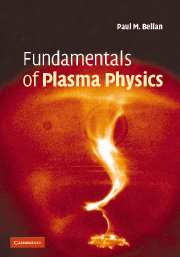Book contents
- Frontmatter
- Contents
- Preface
- 1 Basic concepts
- 2 The Vlasov, two-fluid, and MHD models of plasma dynamics
- 3 Motion of a single plasma particle
- 4 Elementary plasma waves
- 5 Streaming instabilities and the Landau problem
- 6 Cold plasma waves in a magnetized plasma
- 7 Waves in inhomogeneous plasmas and wave-energy relations
- 8 Vlasov theory of warm electrostatic waves in a magnetized plasma
- 9 MHD equilibria
- 10 Stability of static MHD equilibria
- 11 Magnetic helicity interpreted and Woltjer–Taylor relaxation
- 12 Magnetic reconnection
- 13 Fokker–Planck theory of collisions
- 14 Wave–particle nonlinearities
- 15 Wave–wave nonlinearities
- 16 Non-neutral plasmas
- 17 Dusty plasmas
- Appendices
- Bibliography and suggested reading
- References
- Index
4 - Elementary plasma waves
Published online by Cambridge University Press: 05 June 2012
- Frontmatter
- Contents
- Preface
- 1 Basic concepts
- 2 The Vlasov, two-fluid, and MHD models of plasma dynamics
- 3 Motion of a single plasma particle
- 4 Elementary plasma waves
- 5 Streaming instabilities and the Landau problem
- 6 Cold plasma waves in a magnetized plasma
- 7 Waves in inhomogeneous plasmas and wave-energy relations
- 8 Vlasov theory of warm electrostatic waves in a magnetized plasma
- 9 MHD equilibria
- 10 Stability of static MHD equilibria
- 11 Magnetic helicity interpreted and Woltjer–Taylor relaxation
- 12 Magnetic reconnection
- 13 Fokker–Planck theory of collisions
- 14 Wave–particle nonlinearities
- 15 Wave–wave nonlinearities
- 16 Non-neutral plasmas
- 17 Dusty plasmas
- Appendices
- Bibliography and suggested reading
- References
- Index
Summary
General method for analyzing small-amplitude waves
All plasma phenomena can be described by combining Maxwell's equations with the Lorentz force equation where the latter is represented by the Vlasov, the two-fluid, or the MHD approximation. The subject of linear plasma waves provides a good introduction to the study of plasma phenomena because linear waves are relatively simple to analyze and yet demonstrate many essential features of plasma behavior.
Linear analysis, a straightforward method applicable to any set of partial differential equations describing a physical system, reveals the physical system's simplest non-trivial, self-consistent dynamical behavior. In the context of plasma dynamics, the method is as follows:
By making appropriate physical assumptions, the general Maxwell–Lorentz system of equations is reduced to the simplest set of equations characterizing the phenomena under consideration.
An equilibrium solution is determined for this set of equations. The equilibrium might be trivial such that densities are uniform, the plasma is neutral, and all velocities are zero. However, less trivial equilibria could also be invoked where there are density gradients or flow velocities. Equilibrium quantities are designated by the subscript 0, indicating “zero-order” in smallness.
[…]
- Type
- Chapter
- Information
- Fundamentals of Plasma Physics , pp. 146 - 173Publisher: Cambridge University PressPrint publication year: 2006



